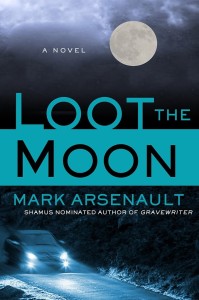Today TKZ is thrilled to welcome author Mark Arsenault, a Shamus nominee and former newsman. Booklist gave his latest release LOOT THE M OON a starred review, describing it as, “a top-notch crime novel.”
OON a starred review, describing it as, “a top-notch crime novel.”
We all remember the newspaper, right? That once ubiquitous part of daily life, now on a fast slide toward an exhibit at the Museum of Obsolescence, where it’ll join the butter churn, the buggy whip, and customer service? (For binary-only types who can’t remember the newspaper, it was like a daily printout of the on-line news. Pretty handy!)
Well, the newspaper still whups the laptop as a fireplace starter and a birdcage liner, and here’s one more—the old fashioned newspaper is the best tool I’ve found for researching historical fiction. For time periods dating as far back as 150 years or so, old newspapers preserved on microfilm beat the Internet as a research tool, and that includes the digitized archives some large newspapers offer on-line. And, no, I have not been hanging around at the polyurethane convention.
When I’m researching a time period for a fictional setting, I might scan old newspaper headlines for factoids, but what I’m really looking for is the advertisements. You can learn a lot about life in another era by what people were buying and selling.
I’ve been researching life on the East coast around 1917 to set a novel. It was a fascinating time period, just 36 years after the gunfight at the O.K. Corral, yet people talked on telephones and drove sporty little cars. How can I be sure? Because I found a great advertisement for the Davis Light Six Roadster, a bargain at $1,095, featuring adjustable seats for “the utmost comfort in motor travel.” For an additional $700, the Hudson Super-Six could top 100 miles-per-hour.
A picture in a bike advertisement shows me that bicycles have barely changed in more than 90 years. I can infer from a dentist’s ad that “pain-free” was a still a selling point in 1917, something we take for granted now.
 I would have guessed that men carried only pocket watches in 1917, but there are also ads for wristwatches with glow-in-the dark “Radiolite” dials. On one old page I recognized a character I’ve known all my life: Mr. Peanut, the tuxedoed nut who peddles for Planters. I had no idea Mr. Peanut was WWI vintage.
I would have guessed that men carried only pocket watches in 1917, but there are also ads for wristwatches with glow-in-the dark “Radiolite” dials. On one old page I recognized a character I’ve known all my life: Mr. Peanut, the tuxedoed nut who peddles for Planters. I had no idea Mr. Peanut was WWI vintage.
Old newspaper ads reveal the attitudes of a culture. Americans in 1917 were modern and naïve at the same time: People played phonograph records back then, went to the movies and drove big Cadillacs. They also paid good money for miracle pills and powders that claimed to cure everything.
Gender roles are obvious in this text from a chewing gum ad: “The high salaried secretary of the big business man knows how important it is to keep her high-strung employer well supplied with Adams Pepsin, the original chicle gum. So she keeps it where he can get it at once without having to ask.”
That pitch probably wouldn’t sell much gum today.
Many libraries keep old newspapers on microfilm. You have to use the microfilm viewer machine, which I call The Vominator because it can make me seasick. But that’s a small price for such a rich resource.
Microfilm may seem too primitive when you can literally download photos from Mars to your phone, but just imagine all those newspages as one big, searchable database. You just search through them one page at a time.
This November’s edition of Ellery Queen’s Mystery Magazine will have a short story of mine set in 1973, a very groovy year. The 70s are my favorite time period for fiction. I love the clothes, the slang, the hair, the cars, the crazy politics. With the Watergate coverage, the 1970s may have been the high-water mark for American newspapers.
Does anyone else have a favorite time period for stories? What makes it your favorite?
Mark Arsenault is a Shamus-nominated mystery writer, journalist, runner, hiker, political junkie and eBay fanatic who collects memorabilia from the 1939 New York World’s Fair. His new novel is LOOT THE MOON, the second book in the Billy Povich series that began with GRAVEWRITER, a noir thriller praised for a fusion of suspense, humor and human tenderness. With 20 years of experience as a print reporter, Arsenault is one of those weird cranks who still prefers to read the news on paper.

I love old newspapers. I have some that my mother saved from WWII–the Battle of the Bulge–because my dad was in the Third Armored Division. I get a kick out of the classified ads. The want ads are separated into male and female sections, and some of the ads would definitely be considered racist now. In the back of my mind, there’s a book percolating set in the 40s.
And if you like the 70s, we’ve been talking about them on Working Stiffs this week–music and TV in particular.
Thanks for stopping by, Mark. I love using microfilm for period research. I go to the downtown L.A. library branch, and like you say, the ads are telling. Also the movies that are playing and the religion page. I was amazed at the variety in turn of the century L.A. Much like today. It’s always been there.
Mark, thanks for visiting TKZ. You’re right, newspapers are a great snapshot of life and the ads have a wealth of information on what people wanted and needed at any given moment. It’s sad to think how much might be lost as our newspapers start to fade into history.
Years ago I was cleaning out my grandfather’s stuff and ran across a bunch of newspapers and magazines from the 40’s through the early 70’s. It was like finding a treasure trove. I poured over them for weeks and got a great snapshot of life in Interior Alaska and the world.
I’ve never had an urge to write about that period though. Other than the present or near future period the only other periods I yearn to write involve pre-Celtic civilization or Mongols. I have searched my local library, and maybe it’s just because I am in Alaska, but I cannot seem to find any editions of the SF Chronicle. Anchorage Daily News, or Washington Post that gets me there.
I am eagerly waiting to stumble across that ancient Irish Gaelic newspaper that must surely be stuffed into a crack between the rocks at Newgrange or Tara. Even if it does have bird droppings on one side.
I’m very sad about the decline of newspapers–my hometown paper is getting mighty thin, and I’ve noticed–the horror!–display ads on the front page. Although I use online searches when I need a factoid fast, I still prefer newspapers for daily reading. A newspaper can be folded into comfortable configurations for reading at odd angles, like when I’m reclining on the couch. And as a certified couch potato, I can say that reading with a laptop while reclining on the sofa is uncomfortable. Never mind the fact that there’s never a plug handy for the power cord.
Another thing I’m worried about is the future quality of news. The online “news” outlets pay little to nothing to their contributors, so the talented journalists are going to have to go into another line of work. The reading public is going to be left with nothing but articles by hacks, hucksters, and corporate marketing departments.